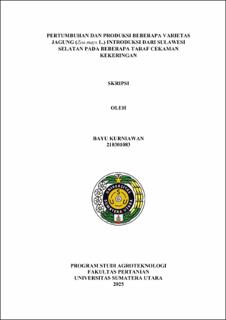Pertumbuhan dan Produksi Beberapa Varietas Jagung (Zea Mays L.) Introduksi Dari Sulawesi Selatan pada Beberapa Taraf Cekaman Kekeringan
Growth and Production of Several Corn Varieties (Zea mays L.) Introduced from South Sulawesi at Several Levels of Drought Stress
Abstract
Corn (Zea mays L.) is a cereal crop originating from the American
continent, specifically Mexico. To increase corn production, extensification and
intensification are necessary. Drought stress is one of the most widespread stresses
affecting growth and production in agricultural areas. This study aims to determine
the growth and production of several corn varieties (Zea mays L.) introduced from
South Sulawesi under various levels of drought stress. The research was conducted
in a greenhouse and analyzed at the Soil Biotechnology Laboratory of the Faculty
of Agriculture, University of North Sumatra, Medan, from January to June 2025.
This study used a Randomized Block Design with 2 treatment factors and 3 blocks.
The first factor was the use of various varieties, namely Lamuru (V1), Bisma (V2),
Sukmaraga (V3), and Srikandi Kuning (V4). The second factor was the treatment
of several levels of field capacity, namely K1 (80%), K2 (60%), K3 (40%), and K4
(20%). The observation parameters included plant height, stem diameter, number
of leaves, leaf area, age at male flowering, age at female flowering, root length at
the end of the vegetative period, root length during the generative period, number
of stomata, harvest age, yield per plant, and yield per plot. The results showed that
the variety factor had a significant effect on plant height, stem diameter, age at
male flowering, yield per plant, and yield per plot, but had no significant effect on
number of leaves, leaf area, age at female flowering, root length at the end of the
vegetative period, root length during the generative period, number of stomata, and
harvest age. The field capacity treatment factor had a significant effect on plant
height, stem diameter, number of leaves, leaf area, male flowering age, yield per
plant, and yield per plot. However, it had no significant effect on female flowering
age, root length at the end of the vegetative period, root length during the
generative period, number of stomata, and harvest age. Based on the study, the
Srikandi Kuning (V4) variety produced the best results in each field capacity
treatment: K1 (80%), K2 (60%), K3 (40%), and K4 (20%).
Collections
- Undergraduate Theses [3569]

